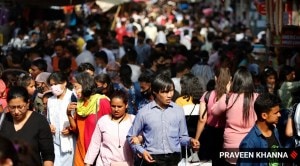- India
- International
Odd-even scheme road test: Did the initiative help bring down air pollution
The third edition of the Delhi government’s odd-even scheme ended on Friday — the same day the Supreme Court sought to know how effective it really is.
 The scheme was in place from November 4-15. (Express photo by Abhinav Saha)
The scheme was in place from November 4-15. (Express photo by Abhinav Saha)
On Wednesday, November 13, as evening sets in and levels of particulate matter (PM) 2.5 climbed steadily, an official monitoring the situation could not help but get frustrated. All construction activity in the city had been suspended a few weeks ago, the second week of the odd-even road-rationing scheme was in place, and schools had been ordered to shut for the next two days.
“This is the highest the GRAP (graded response action plan) goes. We are doing everything we can, but who can control the weather?” said the official.
Under GRAP, an action plan to combat pollution in Delhi-NCR, actions are recommended based on the concentration of pollutants. At lower levels of PM 2.5 and 10, the plan suggests making sure waste is not set on fire in the open, illegal industrial activity is curtailed and roads are vacuum-cleaned. At the highest end of the spectrum are actions such as halting construction, shutting schools and odd-even.
Anticipating an increase in pollution post-Diwali and during crop burning season, the Delhi government had announced in September that the third phase of the odd-even scheme, whereby cars can ply on alternate days based on the last digit of their registration number, will be implemented between November 4 and 15. The scheme, which has been implemented in several countries such as China, Mexico and France in different forms, aims to remove half of the cars from the roads.

This is the third time the scheme has been implemented — the first two times were in 2016 — and all three times, its effectiveness has been hotly debated. The two phases in 2016 had witnessed studies by various agencies that produced conflicting results and leading many to wonder: Does odd-even really work? On Friday, the Supreme Court asked the same question.

The Indian Express analysed the Central Pollution Control Board’s (CPCB) air quality index (AQI) in Delhi, where the scheme was implemented, and compared it with Gurgaon, Ghaziabad and Noida. CPCB releases a 24-hour average AQI for 105 cities in the country every day.
The average AQI in Delhi and the three NCR cities was calculated for the 12 days before odd-even was implemented, and the 12-day period it was in place (including Sundays and two days during Guru Purab, when all cars were allowed to ply).
These four places were chosen as air quality depends on several factors, including a city’s emissions, external emission sources, wind speed, humidity, temperature and wind direction. Since the four cities share borders, similar factors were in play during the comparison period.
The highest drop
The average AQI in Delhi between October 23 and November 3 — before the implementation of odd-even — was 369.5. The highest was 494, recorded on November 3. During odd-even, from November 4-15, the average AQI was 328.5. The highest was 463, on November 14.
The average AQI had decreased during the odd-even phase by 41 points.
A similar comparison in Gurgaon, where odd-even was not in place, showed that the November 4-15 average AQI was higher than the October 23-November 3 figure by 7.6 points. In Ghaziabad, there was a reduction of 13.3 points, and in Noida, by 12.3 points (see box above).
Simply put, the average AQI decreased most significantly in the national capital, where odd-even was in place.

But despite available data — Delhi is the most closely monitored city in the country with the AQI value calculated based on 28-36 stations daily, as compared to 10 in Mumbai, which is the second highest — experts said determining the exact impact of an individual measure on air pollution is very tough.
“As air quality depends on so many different factors, it is not easy to say what the effect one action such as odd-even has. For instance, on the first day that odd-even was implemented, strong winds were seen in the city and by Tuesday, a significant reduction in AQI was noticed. But in the last four days of the scheme, weather conditions were adverse and air quality was in the ‘severe-plus’ category. To say odd-even works or doesn’t will be akin to ignoring all other factors at play,” said a senior official in the Environment Ministry.
“Different studies have said different things about the impact. There are studies showing that pollution increased during the scheme, and there are studies showing pollution came down by 13%-18%,” the official said.
Courtroom drama
The Delhi government faced some tough questions in the Supreme Court, which has taken exception to exemptions given to two-wheelers under the scheme.
“A half-baked odd-even scheme… either you have a full odd-even and give no exceptions… instead you allow two- and three-wheelers which cause more pollution,” Justice Deepak Gupta Friday told senior advocate Mukul Rohatgi, who appeared for the Delhi government.
Rohatgi told the court that studies suggest odd-even can help reduce pollution by 5-12%, and explained that two-wheelers were exempt because the city will “collapse” if they are also brought under the scheme. This is because the public transport system is simply not equipped to handle the load — while there are 35 lakh private cars in the city, the number of two-wheelers stands at 65 lakh.
The bench then asked CPCB member secretary Prashant Gargava, “Are we getting benefited by it?”, to which he replied: “Not more than 3-4%”. He also told the court that of pollution caused by vehicles, cars contribute only 3%.
The Delhi government, in an affidavit, told the apex court that it relied on three external studies “to conclude that the policy works as an effective emergency measure”.
The government cited a study conducted by researchers from IIT-Delhi, IIT-Kanpur, Indian Institute of Tropical Meteorology, Pune, National Physical Laboratory and TERI, which used satellite-based estimates of PM 2.5 to examine the potential decrease due to fewer traffic emissions during odd-even.
“The estimated PM 2.5 represents the level between 10.30 am to 1.30 pm, when the satellites cross this region. The study concluded that the traffic restriction between January 1-15 in 2016 reduced PM 2.5 by 4-6% with a maximum of up to 10%, primarily at three local hotspots in Delhi,” the government told the court.
The second study the government cited was conducted by researchers at Energy Policy Institute, University of Chicago, Centre for Policy Research and Harvard Kennedy School, which studied the first two phases of the scheme.
“The analysis compares Delhi’s monitors with monitors from neighbouring cities in the National Capital Region using PM 2.5 data before, during, and after the two pilot rounds,” the government told the court.
“This second analysis finds that PM 2.5 levels were lower by 14-16% on average during 8 am-8 pm during the odd-even scheme in January 2016. No impact was detected at night. No impact was detected when the programme was repeated in April, most likely because the warmer month of April is marked by greater dispersion of particulates. The researchers conclude that ‘taken together, this suggests that the main value of an odd-even program is as an emergency measure during winter months when car emissions play a more prominent role in affecting air quality’,” it said in the affidavit.
The third study cited by the government was done by researchers from Delhi Technological University and Madan Mohan Malaviya University of Technology, Gorakhpur, during the first phase in January 2016.
“The study reports an average reduction of PM 2.5 by 5.73% and that of PM 10 by 4.70% in the ambient air… which depicts a small but positive impact…,” the affidavit states.
An analysis published in the journal Current Science by researchers at the Indian Institute of Science Education and Research Mohali, Indian Institute of Tropical Meteorology, Pune, and India Meteorological Department, however, said pollution during the period did not come down as people chose to drive during non-restriction hours (before 8 am and after 8 pm) or used taxis and three-wheelers instead of buses and the Metro.
The CPCB, meanwhile, said the scheme may have reduced pollution by a small amount but a “single factor or action cannot substantially” reduce air pollution levels in Delhi.
Researchers also pointed out that Delhi’s location is as much to blame as its internal sources of pollution.
A landlocked state, Delhi’s pollution-related woes start primarily in October, and last till February. The practice of crop stubble burning, which adds a significant amount of pollutants to Delhi’s air in October and November, is at least three decades old but the 2009 water conservation Act implemented by Punjab pushed paddy sowing season forward by almost a month from April to May. This meant that the harvest was also pushed a month forward. When farmers set paddy stubble on fire now, it coincides with the end of monsoon and change in wind direction from south easterly to north westerly, bringing a large pollution load to the capital and the whole of the Indo-Gangetic Plains.
Winters also see a dip in temperature and low wind speed — important factors that aid the accumulation of particulate matter and aerosols.
Apr 19: Latest News
- 01
- 02
- 03
- 04
- 05






































